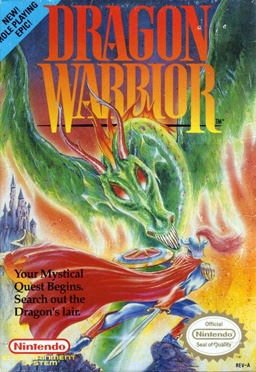From The CRPG Addict
 |
| But does he possess the Power of the Glow? |
AKA Dragon Quest (original Japanese title)
Chunsoft (developer), Enix (publisher)
Dragon Warrior tells the tale of a hero out to defeat an enemy called the Dragonlord. You have to visit two small castles, six small cities, and four small dungeons to collect a series of clues and items necessary to make your way to the Dragonlord and beat him in combat. The whole enterprise takes about an hour.
Oh, except for the grinding. Which took another goddamned sixteen hours. Before I played Dragon Warrior, I thought I knew what it meant to “grind.” I thought I’d done it, in fact, in games like The Bard’s Tale and Wizard’s Crown. I thought it could be kind of fun, allowing you to test out various attack and spell options that you might otherwise have neglected. I even opined on several occasions that I preferred games with a bit of grinding. All of that was before Dragon Warrior held me down and robbed me of my innocence.
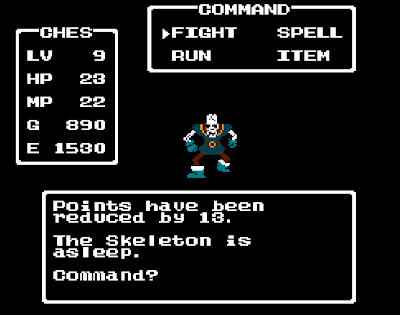 |
| Get used to this screen. |
The basic setup of Dragon Warrior is that you start at a castle. Around the castle are slimes that earn you one hit point and one experience point. Eventually, you have to explore the entire land for the items and clues that will lead you to the endgame. This would only take you about one hour if there were no enemies. But the farther you get away from the castle, the harder the enemies become. At first, you care only about simple survival around the castle and its closest town, Brecconary. Soon, you reach a high enough level that those enemies are no longer a problem, but at that point you have to worry about surviving a trip through the ghosts and magicians that haunt the path to Garinham. Once that’s accomplished, you have to get good enough to defeat the scorpions and skeletons blocking the way to Kol. Every time you start to feel like a badass, the game rudely reminds you that some new, tougher pack of enemies is hovering just over the horizon.
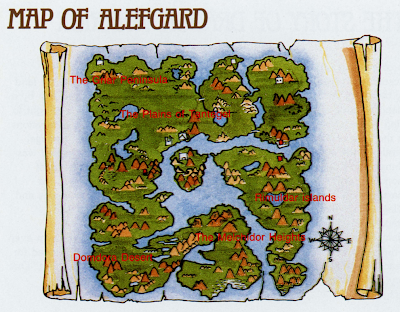 |
| Alefgard, looking a lot like Britannia except that the enemy’s castle is on Buccaneer’s Den. |
Except for the imbalance between gameplay and grinding, Dragon Warrior plays a lot like (and was clearly inspired by) an early Ultima. We’ve got a game world shaped almost exactly like Britannia from Ultima IV, including the position of the castle and first town. We have an iconographic interface. We have a Lord British-like king, a Mondain-like enemy, and a bunch of NPCs in between who offer one-line clues. Beyond this, the developers added some original elements, but not enough to make up for the sheer number of hours that you have to spend fighting slimes.
The backstory is mildly amusing, starting with its redundant opening words: “In olden days of yore.” The realm of Alefgard was once cloaked in darkness–a darkness lifted when a brave warrior named Erdrick defeated “an evil being.” To accomplish this feat, “he used balls of light.” You might guess that the source of these magnificent balls was supernatural or heavenly, but no, they were simply “bequeathed to him by a friend.” When the balls had done their work, Erdrick gave them to King Lorick, who brought peace to the land. But during the reign of King Lorik XVI, the evil Dragonlord stole the balls of light from Tantegel Castle, “and once again the kingdom of Alefgard was plunged into darkness.” Enter the hero.
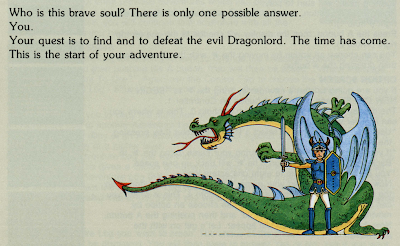 |
| “Right now. This minute. Like, the moment you press START on your controller.” |
Character creation consists only of a name; everyone begins with 3 strength, 3 agility (speed), 15 hit points, 0 magic points, 3 attack power, and 1 defense power.
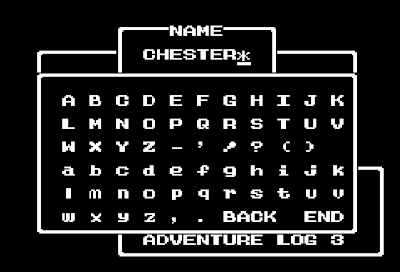 |
| “Character creation.” |
You and your GCLM start in Castle Tantegel (obviously a reference to Tintagel in Cornwall), speaking with King Lorik XVI, who does three things for you throughout the game. First, he tells you how many experience points you need for your next level. Second, he saves the game for you. The throne room is the only place you can save, which is a restriction I don’t mind and even encourage. Third, he resurrects you when you die, although it costs half your gold.
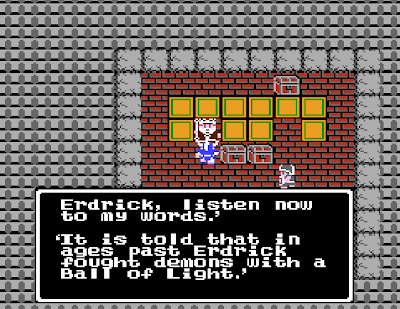 |
| I thought it was balls of light. Plural. |
From the moment you leave Tantagel, you can see the Dragonlord’s castle, Charlock, across the bay. Most of the non-grinding part of the game involves reaching his castle, made difficult because the world of Alefgard apparently has no boats.
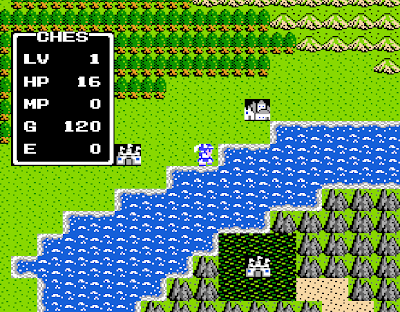 |
| Castle Tantagel, Brecconary, and Castle Charlock. |
To reach Charlock’s island, you have to use something called the “Rainbow Drop” to create a bridge from another nearby island. The Rainbow Drop is a fusion of the Stones of Sunlight (which are different from the Balls of Light, apparently) and the Staff of Rain, and the old wizard who performs this fusion will only do so if you find Erdrick’s Token and thus prove that you’re a descendant of Erdrick. Both the Staff of Rain and the Stones of Sunlight have a couple of precursor quests, but in general you get the idea. NPC clues lead you most of the way.
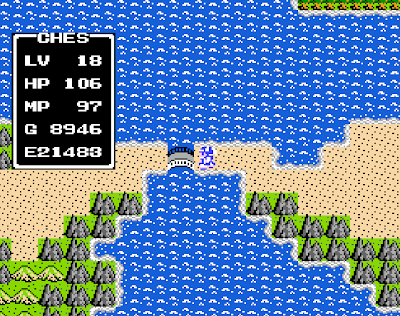 |
| The end result of most of the games items and clues. |
There’s at least one major side-quest in the game, although come to think of it, I’m not sure how it can be a side quest. It involves the rescue of the king’s daughter, Princess Gwaelin, from a green dragon in a dungeon. You’d think her kidnapping would be important enough to mention in the backstory, but the manual doesn’t include it. It’s not a tough battle after Level 10 or so; later, green dragons appear liberally as random encounters.
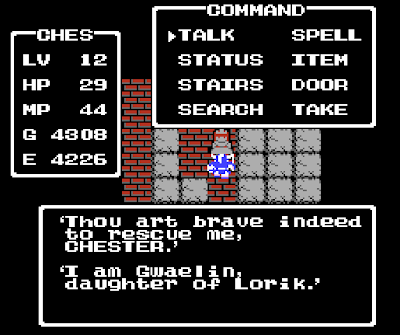 |
| The dragon and princess. |
The rescued princess professes her love for the hero and gives him an item called “Gwaelin’s Love.” Whatever it is, it allows him to communicate with her from anywhere in the game, and she takes over Lorik’s responsibility of telling the hero how many experience points he needs for the next level. She also tells him where he is in respect to the castle, which I thought was fairly useless information until I got a clue to find Erdrick’s Token 70 leagues south and 40 leagues east of the castle. Still, I feel like I could have figured out the location without Gwaelin’s coordinates, so it makes me wonder what prevents me from winning the game without having rescued Gwaelin first. Since she shows up in the endgame, I assume something does.
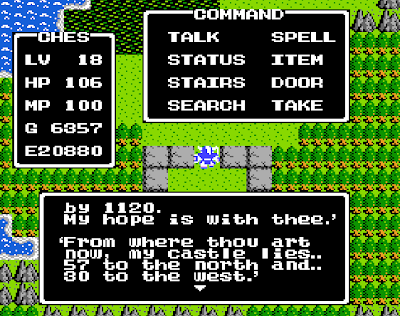 |
| I feel like I could have accomplished this by just counting steps. |
Other than Erdrick’s Sword, which is found in Charlock, this is all you need to defeat the enemy mechanically. Defeating him functionally is a different story. You can’t hope to reach him, let alone defeat him, unless you’re at least Level 18. I defeated him at Level 19, but it took me four tries and I was abusing save states to “reload.”
This is where the grinding comes in. Level 19 requires 22,000 experience points, and if all you did was walk from city to city picking up clues and items, and then make your way to the Dragonlord, you’d only earn about 1,000 experience points from the random combats along the way. The other 21,000 experience points you must seek out for yourself.
 |
| The hustle and bustle of a typical Dragon Warrior town. |
Combat comes upon you randomly as you wander across the landscape or through (most) dungeons, and it is more akin to Wizardry than Ultima. You only ever face one enemy at a time. He might surprise you and get a free attack, but otherwise combat begins with your options to fight, cast a spell, flee, or use an item. Running works often enough to get you out of a tight spot, but not so often that you can use it to pass through areas far above your level. The few items that you can use in combat stop being useful after the early levels. So most of the time, you’re fighting or casting.
Fighting does a modest amount of damage based on your strength and weapon. Occasionally, you get lucky with a critical hit or (as the game has it) “excellent move.” Occasionally, the enemy parries entirely.
Most of the strategy of combat, to the extent that it has any, is in the few spells. You acquire them in stages as you level up. “Heal” comes at Level 3 and greatly extends your ability to grind in between inn stops (resting at inns is the only way to restore all health and magic). “Hurt” (Level 4) harms enemies, and “Sleep” (Level 7) puts them to sleep for at least one round. “Stopspell” (Level 10) negates enemy magic, and “Healmore” (Level 17) and “Hurtmore” (Level 19) are super-powered versions of their weaker cousins.
 |
| Fighting a harder enemy late in the game. I had him under a “Sleep” spell, but he woke up at the last hit. |
“Sleep” is pretty useful from the moment you acquire it, and if you’re lucky it will put enemies to bed for enough rounds that you can hack them to death. The problem is that when you’re grinding for a handful of experience points at a time, quantity is more important than quality. You want to stay in areas where you don’t have to resort to “tactics”–where you can just hold down the “Fight” option and plow through them. This means that for the first hour, you’re killing slimes, red slimes, and occasionally “drakees” around the castle for 1-2 experience points each.
Once you hit Level 5 (110 experience points), you can make it to the city of Garinham without dying. Then you’re stuck battling ghosts, magicians, and “magidrakees” at 3-5 experience points each for a couple of hours until, say, Level 8. From there, you move to the city of Kol, which is surrounded by skeletons and scorpions with 6-11 experience points each. By Level 12 (4000 experience), you can survive for long periods of time on the large southern island (accessible through a dungeon), where warlocks, wolves, werewolves, wolflords, and wyverns occupy you for 13-40 points each.
 |
| The first level-up. |
The far southern parts of the map are swarming with enemies capable of casting high-level spells. They include wraith knights, starwyverns, magiwyverns, green dragons, axe knights, and demon knights. The most valuable has maybe 70 experience points. I never reached a point where I was comfortable mindlessly grinding through this lot, but after you pass Level 13, you have the “Return” spell, which automatically warps you back to the safety of the castle, so you can afford to take more risks. I finished the game at Level 19 with 22,500 experience points, but it goes all the way to Level 30 and 65,535 experience points. Who in the world would take it that high?
Leveling up has a palpable effect on combat difficulty, with each new level contributing a boost in strength, agility, maximum hit points, maximum magic points, and perhaps a new spell. But you’re not just grinding for the experience. You’re also grinding for the gold, so you can buy improved equipment. (There are a handful of chests in the game, but not enough to deliver significant gold rewards.) Early in the game, you earn gold at a rate of about 1 for every 2 experience points, but against higher-level enemies the ratio reverses, and soon you’re earning double the amount of gold as experience.
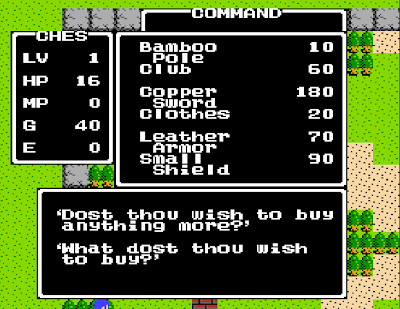 |
| The paltry selection in the first town. |
Gold is used to purchase weapons, which go in this order: bamboo pole (10 gold), club (60), copper sword (180), hand axe (560), broad sword (1500), and flame sword (9800). Armor progresses as follows: clothes (10), leather armor (70), chain mail (300), half plate (1000), full plate (3000), and magic armor (7700). Shields are small (90), large (800), and silver (14800). As you upgrade, the shop will give you half the value of your current items back to you, but it won’t let you buy the new item until you have enough gold without considering the buy-back. So when you go to upgrade from chain mail to half plate, the shop will offer 150 for the chain mail, but you can only make the offer when you have the 1000 needed for half plate on its own, not 850.
At first, I thought it would be a constant mental struggle whether to buy the next incremental upgrade or hold out for a higher level. For instance, do you bother to upgrade from chain mail to half plate, or just save your gold until you can go to full plate? But you can’t really move on until you have enough experience anyway, and getting to the requisite experience levels generally means that you have enough gold to hit every incremental improvement along the way. The only purchase that I felt was wasted was the magic armor, as I found “Erdrick’s Armor” shortly after I bought it. Erdrick’s Armor heals you 1 hit point every step you take and protects you against damage from swamps and magic barriers, and in an replay or walkthrough-assisted game, it would be worth a suicide mission, running from as many enemies as possible, as soon as you can plausibly hope to reach it.
The game has a few other usable items that are fairly clever. Dragon’s scales raise your defense temporarily; fairy water prevents enemies from attacking for short periods; herbs restore hit points; and wings cast the “Return” spell and warp you back to the castle. You also have to buy magic keys to fully explore the interiors of towns and dungeons.
Once I had the necessary items and Erdrick’s Armor, which generally assured I could reclaim my hit points between battles without wasting magic points, I decided to take on Castle Charlock. The first level has a throne but no occupant, and I had to fiddle around with search options to find a hidden staircase behind the throne.
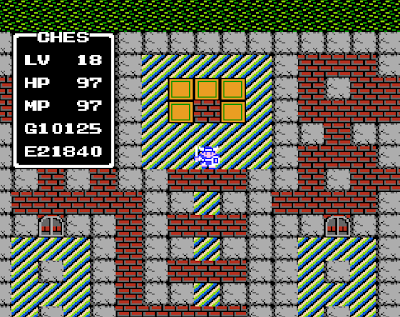 |
| My armor protects me against the magic barriers as I approach an empty throne. |
Below the hidden stairs are eight dungeon levels, one of which has a chest holding Erdrick’s Sword. Fortunately, I found it before meeting the Dragonlord because I understand it’s necessary to kill him, yet I don’t recall getting any clue to that effect.
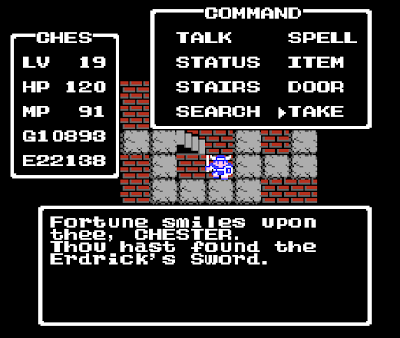 |
| That was lucky. |
The bottom level is a large one, but you ultimately encounter the Dragonlord in his “real” throne. He immediately offers you a deal: “To share this world and to rule half of it if thou will now stand beside me.” Of course I had to say yes the first time. He replied: “Really? [I think I had to say “yes” again.] Then half of this world is thine, half of the darkness, and . . . if thou dies, I can bring thee back for another attempt without loss of thy deeds to date. Thy journey is over. Take now a long, long rest. Hahahahaha . . . .” The screen turned red and the game was over.
I’m not really sure what happened there, but I think there was a glitch. “Without loss of thy deeds to date” is text from the king’s offer to save your game. I suspect something else was supposed to appear there that made it clear the Dragonlord was betraying me. Or else it was an ironic echo of the king’s offer.
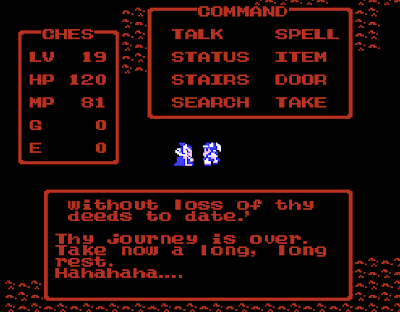 |
| I mean, I would like to take a long rest. But the “hahahahaha” part makes me suspicious. |
Either way, I reloaded and said no. A battle against the Dragonlord commenced and ended after three rounds. But then, “The Dragonlord revealed his true self!” and turned into a dragon. I’d like to say this was a major plot twist, but he kind of gave it away by calling himself “Dragonlord.”
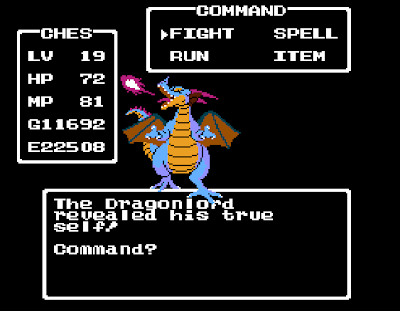 |
| It turns out he’s kind of racist. |
The dragon Dragonlord was much tougher, and as I mentioned above, it took me four tries to beat him. The issue was mostly that I needed to cast “Healmore” every two rounds, and eventually I would run out of magic points. (No other spells seem to work in battle against him.) If I had been playing without save states, waking up in the castle at every loss, I would have spent another few hours grinding. As it was, I just kept trying until I got a luckier sequence of random numbers where I only had to “Healmore” every three rounds instead of every two. That left me enough attacks in between to slice away his hit points.
Once he was dead: “Thou hast done well in defeating the Dragonlord. Thou hast found the Ball of Light. [I still want to know what happened to the other ones.] Across the land spreads the brilliance until all shadows are banished and peace is restored.”
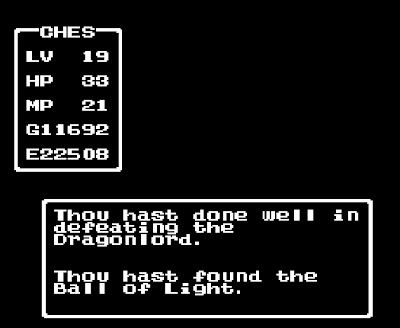 |
| Was the Ball of Light really necessary as a plot point? |
I was teleported back to the castle, where the king said that the legends were true and I was the “line of Erdrick.” He offered me his throne, but the game had me automatically decline. “If ever I am to rule a country,” Chester said, channeling Conan, “It must be a land that I myself find.” One wonders how he’ll “rule” a place that has no other people, but we’ll let it go for now.
 |
| “I will have my own kingdom, my own queen.” |
Gwaelin immediately volunteered herself as a companion on my journey. (Honestly, I didn’t mean to suggest I was leaving today.) The game offered me “yes” and “no” options, but if I said “no,” Gwaelin responded, “But thou must!” and I got the “choice” again. So I made her happy by accepting. “And thus the tale comes to an end . . . unless the dragons return again.”
 |
| Which they will, at least 12 times, in the main series alone. |
There was a nice animation of some trumpeters playing before the final screen. That puts me in mind to talk about the game music. Because I haven’t otherwise focused much on music, I don’t know what game first introduced the idea of multiple background themes for each major division of gameplay, including outdoor exploration, town exploration, dungeon exploration, and combat. The first that I can remember is Ultima IV, and it wouldn’t surprise me if Sugiyama took his musical cues from Kenneth Arnold. But where Arnold’s compositions are mostly homophonic, with one clear melody line supported by complementary chords, Sugiyama’s uses a complex polyphony (multiple melodies operating at once). I thought the complexity was utterly lost on the era hardware, but I admired it nonetheless. Of course, I turned it off after a few minutes, as usual, because I don’t like repetitive background music no matter how much I admire the counterpoint.
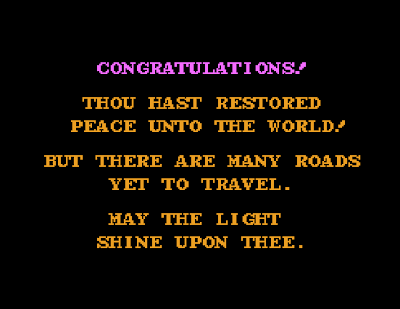 |
| The winning screen. |
As for the rest of the game, I found it trite and boring. The running-around-looking-for-clues portion is no more advanced than we saw in the original Ultima five years earlier, but instead of making a 6-hour game out of what they had, the developers of Dragon Warrior bulked things up with a lot of tedious grinding. However, the game is undoubtedly an RPG. It is probably the earliest console RPG (available in English, anyway) that we don’t have to qualify with prefixes like “quasi-” and “proto-.” On my GIMLET, it earns:
- 2 points for a basic, uncomplicated game world.
- 3 points for character creation and development. Character creation is nothing, but development is rewarding enough–the one thing other than sound that’s more advanced here than in early Ultima.
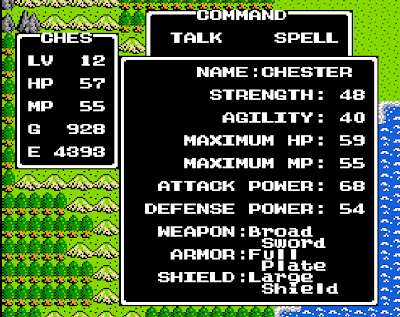 |
| My character sheet a little more than halfway through the game. |
- 4 points for NPCs. This is the earliest JRPG that I can remember to include a healthy number of clue-givers and lore-speakers.
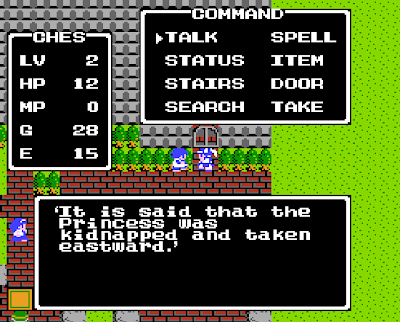 |
| NPCs offer a lot of one-line hints. |
- 2 points for encounters. Enemies aren’t much differentiated except for those with spell abilities and those without. There are no non-combat encounters.
- 2 points for magic and combat, both fairly primitive.
- 3 points for equipment. The linear progression of weapons and armor is balanced by some creative usable items.
- 4 points for the economy. It lacks complexity, but it sure does remain relevant for most of the game.
- 3 points for quests. In addition to the main quest, there are a few side areas. Notably, I forgot to follow a clue to a “Warrior’s Ring” that might have helped.
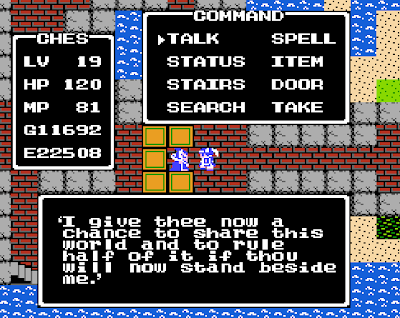 |
| This should be standard in RPGs, but without the subsequent betrayal. |
- 4 points for graphics, sound, and interface. I don’t like the graphics of this era in general. I would prefer the smooth, crisp lines and distinct colors of pure abstract iconography over the early console era’s attempts to depict complex things with limited hardware. (Graphics are credited to Akira Toriyama, better known as the creator of Dragon Ball.) The sound is occasionally fun but not in any way atmospheric. The console controls, infantile as they are, work reasonably well for the limited number of commands the game offers.
 |
| When you’re bringing the princess home, the icon changes to show you carrying the princess–which is just a bit too difficult to convey using the graphics capabilities of the system. |
- 2 points for gameplay. Too linear, not replayable, and too long. I wouldn’t say it’s “too hard,” because that depends on how long you make it, but even for a moderate level of difficulty, it’s too long.
That gives us a final score of 29, which is below my recommended threshold but in some ways still high given its place as the first incontestable console RPG. I could see it whetting a player’s appetite for RPGs, like Questron did for me, without being a great RPG itself.
Kurt Kalata covers the history of Dragon Warrior–or more properly Dragon Quest, as it’s known in Japan–in an article at GamaSutra. Developers Yuji Horii and Koichi Nakamura attended the 1985 Macworld Conference & Expo in San Francisco and were enchanted with Wizardry and Ultima but deliberately decided to simplify Wizardry‘s combat mechanics for the average console player. (I find it amusing that the “dumbing down” of console games, often argued by computer game partisans and contested by console partisans, is directly confirmed by the accounts of early console developers.)
In Japan, sales were slow but ultimately developed quite well. The 1989 North American release (the one that I played) featured some upgrades from the original, including the hero’s icon changing to match direction of travel and a battery save rather than a password save. It sold poorly and got mediocre reviews, as much more complex games had come along in the intervening period, but the game’s enduring fame was assured when Nintendo Power started giving free copies to subscribers.
The name change in North America was due to the’ tabletop RPG DragonQuest (originally a competitor to Dungeons and Dragons but acquired by TSR in 1989), but I’ll revert to the original title in discussing the future. Dragon Quest II came out in 1987 for the MSX and NES (North American release in 1990) and Dragon Quest III a year later (North American release in 1992). Each stepped up the complexity of inventory, economy, and combat, and most of all allowed for multiple characters in the party and multiple enemies in combat. After that, the public got a new Dragon Quest game every two-to-five years, culminating in Dragon Quest XI in 2017. Dragon Quest XII is currently under development. The main series has kept the same primary team of developers throughout its history.
A spinoff series called Dragon Quest Monsters started in 1998 (last release in 2016), heavily inspired by Pokémon. The Mystery Dungeon series (1993-2006) were a quartet of roguelikes based on Dragon Quest characters and themes. One common enemy in the Dragon Quest environment, Slime, got an action-adventure series between 2003 and 2011. There were also board games, card games, manga, novels, and anime. The main series has continued to enjoy western releases, and Enix has been able to use the original title since 2003, when they registered Dragon Quest in the United States with no objections from the then-owners of the DragonQuest copyright, Wizards of the Coast.
I think only the most recent release, Dragon Quest XI, is on my official list, as it’s the only one to appear on the computer as well as the console. We’ll see if I ever reach it or get to any of the others. This week, Dragon Warrior was supposed to be a quick piece that I was going to hold in reserve in case I failed to make my publication goals on any of the primary games, but it took me so long that I had to publish it immediately instead of the next Challenge of the Five Realms entry. I should have learned a long time ago that I can never plan for a four-hour, one-entry game, no matter how primitive the mechanics. Such games do happen, but only when you aren’t deliberately counting on them.
Between Dragon Warrior, Bokosuka Wars, Deadly Towers, and the PC JRPGs that I’ve managed to play, I’m satisfied that I’ve covered enough of the early JRPG era and early console era. If I decide to try a console game again, I’ll feel comfortable leaping to one of the landmark games from the late 1980s rather than experiencing everything in between. But don’t look for that soon.
Original URL: http://crpgaddict.blogspot.com/2019/12/game-349-dragon-warrior-1986.html

